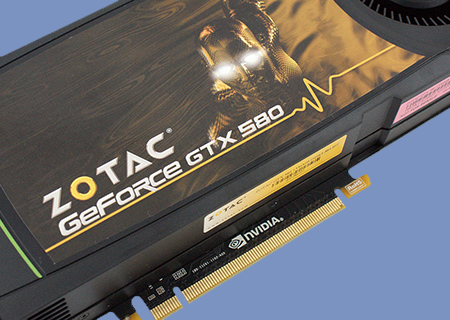Zotac GTX580 Review
Â
Â
Â
Â
Â
Â
Â
Â
Â
Â
Â
Â
Â
Introduction
We waited and waited. Eventually after somewhat of a delay nVidia launched their Fermi range of cards to much excitement from all of us. Or at least it was excitement until we realised that they had been reduced in performance in a vain attempt to get them to remain remotely cool, but even then they were woefully noisy and hot. A pair of GTX480s in SLI gave out a similar amount of heat to an exploding star, and about the same noise.
nVidia secretly went back to their labs and greatly revised the Fermi 100, and here it is. Much sooner than any of us expected we have the GTX580. This comes hot on the heels of the recently released AMD 6-series cards and so undercuts AMDs own high-end graphics package, the HD6990. As this is the first time for a while that nVidia have hit the market before the equal AMD card we can’t wait to see how the gauntlet has been thrown down.
nVidia claim this is everything the GTX480 should have been, with all the hardware tricks and tweaks turned on and a greatly revised cooling solution. They go so far as to call it the best graphics card on the market. Of course claims and reality don’t always meet.
Let’s have a look at the specifications and see if this is a revolution or purely an evolution.
Technical Specifications
So what are the main points? Firstly nVidia have finally unlocked all the shaders so the card is operating at full power. The GTX480 had them cut from 512 back to 480, but here they’re all available for our use.
Despite this nVidia have also given the core speed a kick up the behind and greatly increased the speed across the board which has the obvious benefits everywhere.
Slightly less obvious are some under-the-hood tricks employed to also reduce the load, and therefore heat, of the card whilst dedicating more time to producing high frame-rates. This is largely due to an improved algorithm that determines what is visible and what is hidden, and so the card spends less time rendering polygons that will be hidden on the z-axis. The other major change is the ability of the GF110 to filter a texture per clock cycle. This will have the most visible frame-rate benefits in games that use a lot of texture filtering such as the high-dynamic range option in the popular Bethesda range of RPGs.
So with that said, here are the specifications.
- New ZOTAC GeForce® GTX 580 graphics card
- World’s fastest DirectX® 11 graphics card
- NVIDIA® Fermi architecture – DirectX® 11 done right
- NVIDIA® GeForce® GTX 580 graphics processor
- Engine clock: 772 MHz
- 512 unified shaders
- Shader clock: 1544 MHz
- 1536MB of GDDR5 memory
- 384-bit memory interface
- Memory clock: 4008 MHz
- PCI Express 2.0 interface (Compatible with 1.1)
- Microsoft DirectX® 11 with Shader Model 5.0 and DirectCompute support
- OpenGL® 4.1 compatible
- NVIDIA® CUDA™ ready
- NVIDIA® 3D Vision™ Surround ready
- NVIDIA® SLI™ ready (3-way)
- Hardware video decode acceleration technology
- HDMI 1.4a compliant
- xvYCC Color & DeepColor compatible
- Hardware-accelerated Blu-ray 3D ready
- ZOTAC® Boost Premium software bundle included



